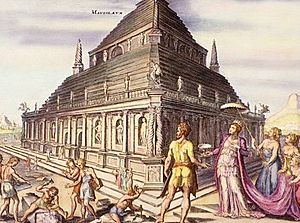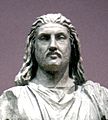Mausoleum at Halicarnassus facts for kids

The Mausoleum at Halicarnassus, also known as the Tomb of Mausolus, was a huge and beautiful tomb built a very long time ago, between 353 and 350 BC. It was located in a city called Halicarnassus, which is now Bodrum in Turkey.
This amazing building was made for Mausolus, who was a powerful ruler (called a satrap) in the Persian Empire. It was also built for his wife and sister, Artemisia II of Caria.
Building a Wonder of the World
The Mausoleum was designed by two talented Greek architects named Satyros and Pythius of Priene. It was incredibly tall, reaching about 45 meters (which is about 135 feet) high! That's like a 15-story building today.
Each of the four sides of the tomb was decorated with amazing sculptural reliefs. These were carved by four famous Greek sculptors: Bryaxis, Leochares, Scopas, and Timotheus.
The building was so impressive that Antipater of Sidon said it was one of the Seven Wonders of the World. Today, the word mausoleum is used for any large and grand tomb.
Images for kids
-
Coinage of Mausolus as Achaemenid dynast of Caria. Head of Apollo facing/ Zeus Labrandos standing, legend ΜΑΥΣΣΩΛΛΟ ("Maussollo"). c. 376–353 BC.
-
Mausolus (casting from the Pushkin Museum).
-
Colossal statues of a man and a woman from the Mausoleum at Halicarnassus, traditionally identified as Mausolos and Artemisia II, around 350 BC, British Museum.
-
This lion is among the few free-standing sculptures from the Mausoleum at the British Museum.
-
Slab from the Amazonomachy believed to show Herculeas grabbing the hair of the Amazon Queen Hippolyta.
-
The design of the Shrine of Remembrance in Melbourne was inspired by that of the Mausoleum.
-
The Masonic House of the Temple of the Scottish Rite, Washington, DC, designed by John Russell Pope, 1911–1915, another scholarly version.
See also
 In Spanish: Mausoleo de Halicarnaso para niños
In Spanish: Mausoleo de Halicarnaso para niños

















